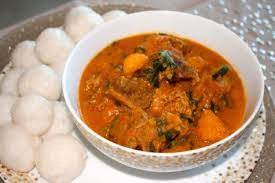
Tuwo Shinkafa: A Staple of Northern Nigerian Cuisine

Tuwo Shinkafa is a traditional dish from Northern Nigeria, cherished for its simplicity and versatility. Made from rice, this dish is a staple in the Hausa and Fulani communities and is often paired with a variety of soups and stews, making it a cornerstone of many meals across the region. In this recipe post, we’ll delve into the origins of Tuwo Shinkafa, its nutritional benefits, and provide a detailed step-by-step guide on how to prepare this beloved dish at home. The Origins of Tuwo Shinkafa Tuwo Shinkafa is deeply rooted in the culinary traditions of Northern Nigeria, where rice is a prominent ingredient in everyday meals. The name "Tuwo Shinkafa" directly translates to "rice meal" in Hausa, which reflects its primary ingredient and the region's reliance on rice as a dietary staple. This dish is typically enjoyed with various local soups like Miyan Kuka (baobab leaf soup), Miyan Taushe (pumpkin soup), and Miyan Zogale (moringa leaf soup), creating a satisfying and nourishing meal. Historically, Tuwo Shinkafa has been a symbol of hospitality and communal eating in Northern Nigerian culture. It is often served during special occasions, such as weddings, religious festivals, and family gatherings, where it brings people together to share in the warmth of a home-cooked meal. Nutritional Benefits of Tuwo Shinkafa Tuwo Shinkafa is not only a comforting dish but also a nutritious one. Here are some of the key nutritional benefits: Source of Energy: As a carbohydrate-rich dish, Tuwo Shinkafa provides a significant amount of energy, making it ideal for sustaining long periods of physical activity. Gluten-Free: Since it is made from rice, Tuwo Shinkafa is naturally gluten-free, making it a suitable option for individuals with gluten sensitivities or celiac disease. Rich in Vitamins and Minerals: Depending on the type of rice used, Tuwo Shinkafa can be a good source of essential vitamins and minerals, including B vitamins, iron, and magnesium. Easily Digestible: The soft, mashed consistency of Tuwo Shinkafa makes it easy to digest, which is beneficial for those with digestive issues or during convalescence. Ingredients for Preparing Tuwo Shinkafa To prepare Tuwo Shinkafa, you will need the following ingredients: Rice: 2 cups of short or medium-grain rice (preferably sticky rice, but any rice variety can be used) Water: 4-5 cups (depending on the type of rice and desired consistency) Salt: A pinch (optional, to taste) Step-by-Step Guide to Preparing Tuwo Shinkafa 1. Selecting the Right Rice The first step in making Tuwo Shinkafa is choosing the right type of rice. Traditionally, short or medium-grain rice is used because of its ability to become sticky when cooked, which is essential for achieving the desired texture of Tuwo Shinkafa. However, if you can't find short-grain rice, you can use other types of rice, though the texture may vary slightly. 2. Washing the Rice Rinse the Rice: Place the rice in a large bowl and rinse it under cold water to remove any excess starch. This step helps to prevent the rice from becoming too gummy. You may need to rinse the rice several times until the water runs clear. Drain the Rice: After rinsing, drain the rice using a colander or sieve to remove as much water as possible. 3. Cooking the Rice Boil the Water: In a large pot, bring 4-5 cups of water to a boil over medium heat. The amount of water you use will depend on the type of rice and the desired consistency of the Tuwo Shinkafa. For a softer, more mashed texture, use more water. Add the Rice: Once the water reaches a rolling boil, add the washed rice to the pot. Stir briefly to ensure that the rice is evenly distributed in the water. Cook the Rice: Cover the pot and reduce the heat to low. Allow the rice to cook for about 20-30 minutes, or until it has absorbed most of the water and become very soft. You can occasionally stir the rice to prevent it from sticking to the bottom of the pot. 4. Mashing the Rice Mash the Rice: Once the rice is fully cooked and soft, use a wooden spatula or pestle to mash the rice directly in the pot. This step is crucial for achieving the smooth, dough-like consistency that characterizes Tuwo Shinkafa. Continue mashing until there are no visible grains of rice, and the mixture has come together as a cohesive mass. Adjust Consistency: If the Tuwo Shinkafa is too thick, you can add a small amount of hot water and continue mashing until you reach the desired consistency. Conversely, if it is too soft, you can allow it to cook for a few more minutes uncovered to evaporate some of the excess moisture. 5. Shaping and Serving Tuwo Shinkafa Shape the Tuwo Shinkafa: Once the rice has been mashed to your liking, it's time to shape it. Wet your hands with cold water to prevent sticking, then scoop out a portion of the Tuwo Shinkafa. Shape it into a ball or mound using your hands or a serving spoon. Repeat this process until all the Tuwo Shinkafa has been shaped. Serve Hot: Tuwo Shinkafa is best served hot and fresh. It pairs wonderfully with a variety of traditional Nigerian soups and stews. Some popular pairings include Miyan Kuka, Miyan Taushe, and Okra soup. Tips for the Perfect Tuwo Shinkafa Use the Right Rice: For the best results, use short or medium-grain rice, which will yield a stickier, more cohesive Tuwo Shinkafa. If using long-grain rice, be aware that the texture may not be as smooth. Mind the Water Ratio: The amount of water you use will greatly affect the texture of the Tuwo Shinkafa. Start with less water if you're unsure and add more as needed during cooking. Mash Thoroughly: The key to a smooth Tuwo Shinkafa is thorough mashing. Take your time during this step to ensure that the rice is well-mashed and free of lumps. Serve Immediately: Tuwo Shinkafa is best enjoyed immediately after preparation while it is still hot and soft. If it cools, it may harden slightly, but you can reheat it with a bit of water to restore its texture. Nutritional Information and Health Considerations Tuwo Shinkafa is a simple yet nourishing dish that can be enjoyed by people of all ages. Here’s a quick overview of its nutritional profile: Calories: Tuwo Shinkafa is relatively low in calories, depending on the type of rice used. It's a filling dish that provides long-lasting energy. Carbohydrates: As a rice-based dish, Tuwo Shinkafa is high in carbohydrates, making it an excellent source of energy, especially for those with active lifestyles. Low in Fat: Tuwo Shinkafa is naturally low in fat, which makes it a heart-healthy option, especially when paired with nutrient-rich soups. Gluten-Free: Because it is made from rice, Tuwo Shinkafa is suitable for those following a gluten-free diet. Conclusion Tuwo Shinkafa is more than just a meal; it’s a testament to the rich culinary heritage of Northern Nigeria. Its simplicity is its strength, allowing it to serve as a versatile base for a variety of flavorful soups and stews. Whether you’re serving it at a special gathering or as part of a weekday meal, Tuwo Shinkafa offers a comforting and satisfying experience. By following this guide, you’ll be able to prepare Tuwo Shinkafa in your own kitchen, bringing the taste of Northern Nigeria to your table. With its soft, smooth texture and subtle flavor, Tuwo Shinkafa is sure to become a favorite in your home. Enjoy this dish with your favorite Nigerian soup and savor the rich flavors and traditions it represents.